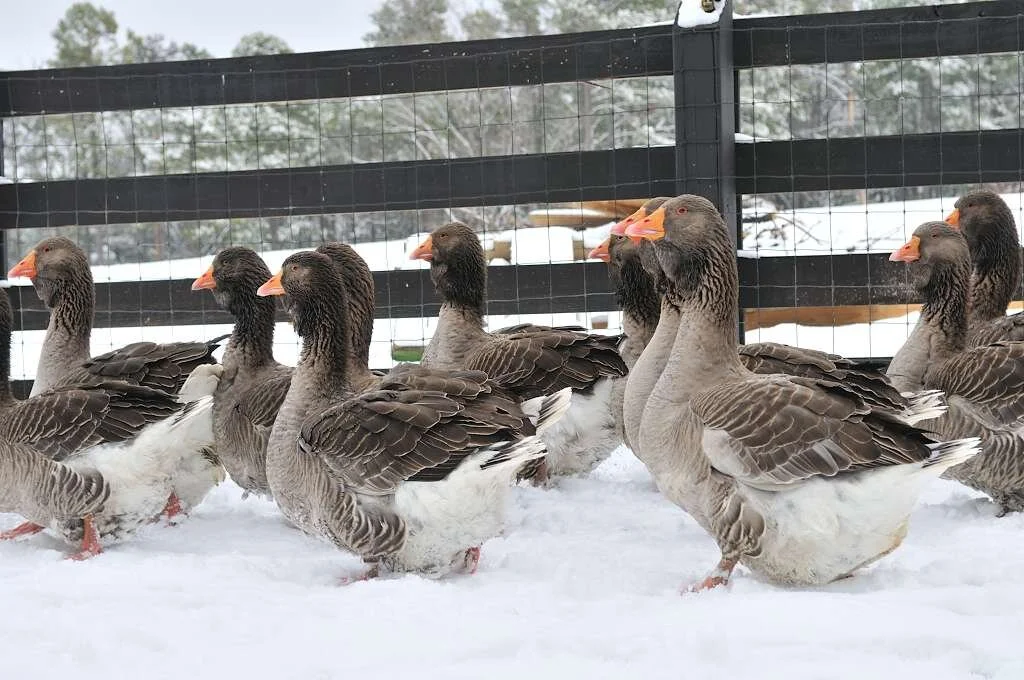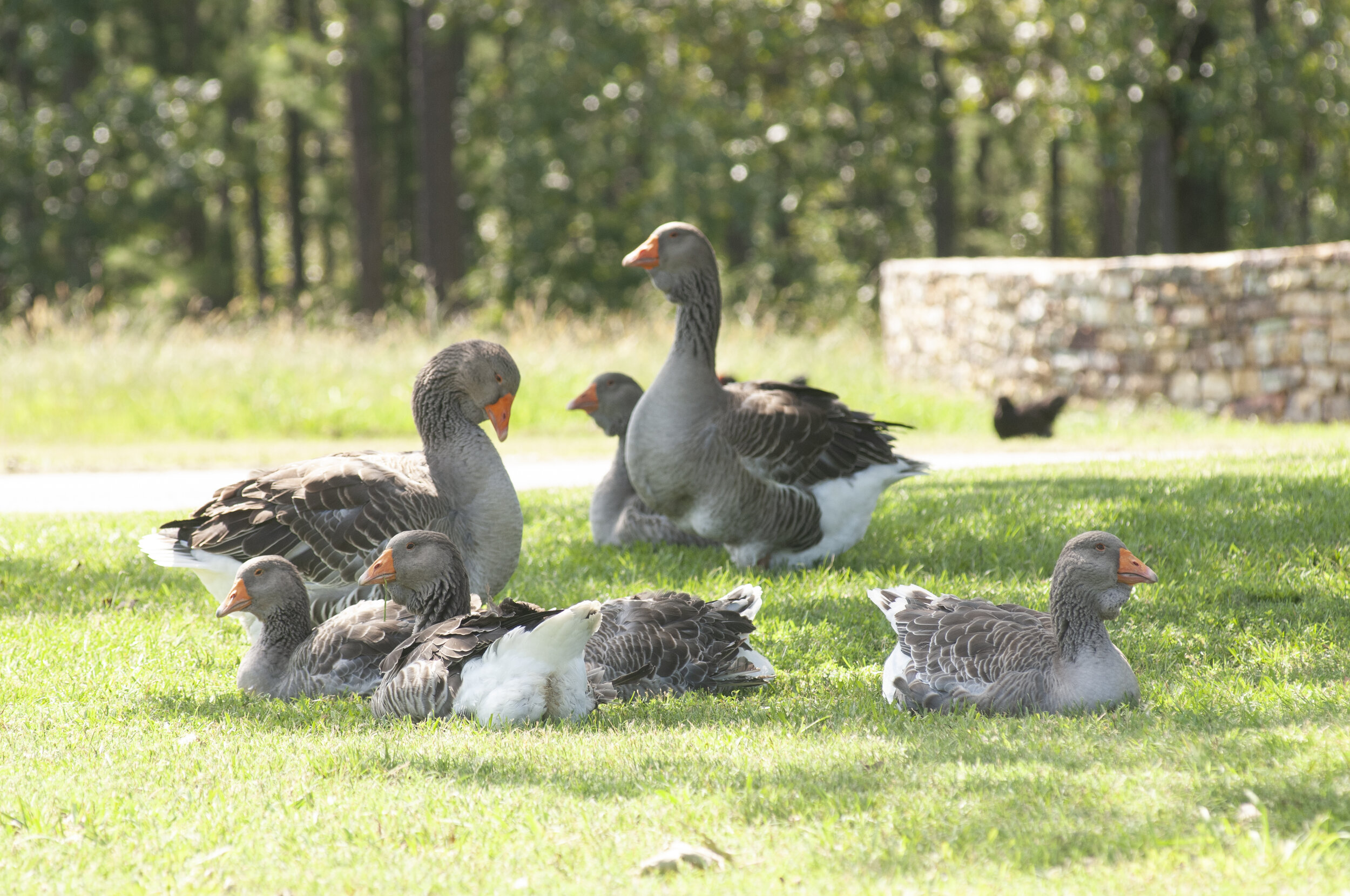The Tufted Roman (Light Goose class) is a small, compact lightweight breed of goose that is characterized by a tuft of feathers on top of its head. The Tufted Roman is only recognized in white and was admitted to the American Poultry Association’s (APA) Standard of Perfection in 1977.
The standard weights are as follows:
Old Gander: 12 lbs.
Old Goose: 10 lbs.
Young Gander: 10 lbs.
Young Goose: 9 lbs.
The body of the Tufted Roman is rather short and plump with a well-fleshed carcass and fine bones. The paunch is dual lobed and should be held tight and close to the body with little tendency to sag. Keep in mind, however, that females just prior to and during egg production will have enlarged paunches. The back is medium in width and should be about twice as long as it is broad, while the breast is full and well rounded. The neck is moderately long and stout with a slight arch. The breed’s most notable feature is the cylindrical tuft of feathers located on the crown which starts at a line even with the back of the eyes and inclines backward. The plumage is pure white while the bill is pinkish to reddish-orange and the shanks and feet are orange to pinkish-orange. The eyes are bright blue.
The ancestor of our modern Tufted Roman is, at least in part, the non-tufted Roman that was once very common in Italy as well as southern and central Europe. These non-tufted geese were characterized by their small size and compact plump bodies very similar to the Tufted Romans we see today. This original non-tufted Roman ancestor is believed to be a very old landrace breed. In fact, small white geese have been known in Italy for 2,000 years and were revered by the people as sacred animals of the god Juno (the goddess of marriage). These small white geese were eventually spread to the rest of Europe by the Roman armies and became well-known throughout the continent. It is not known when the first tufted birds appeared in the breed, but literature of the early 1900’s, cites that many Roman geese had a small crest at the back of the head.
Some waterfowl authors believe this is not the only possible explanation of the origin of the modern Tufted Roman. Well-known waterfowl authority Oscar Grow suggested that tufts, like crests in ducks, can show up in any breed, particularly in English and German geese, and it is from these various tufted birds that the Tufted Roman descended from. Grow reasoned that because many early American tufted geese more closely resembled English birds in terms of body shape and size rather than the original non-tufted Roman that the breed should not have been called Roman.
However, other authors of later years have argued that most tufted geese in the United States did, in fact, resemble the old non-tufted Roman in terms of size, body shape, and color and therefore deserved the designation Roman in the name. It was further argued that these birds had the same temperament and egg-laying ability as the non-tufted Roman. With this assertion and the fact that tufted Roman geese have been described since the early 1900s, it is probably safe to guess that our modern Tufted Romans are the result of a mutation that occurred in non-tufted Romans. However, it is still not out of the question that other tufted geese may have been crossed into these birds and were then bred back to Roman breed characteristics.
There are no clear records indicating when the first Romans were first imported to the United States. What we do know for a fact is that Richard Gidley, of Salem, Ohio imported some in the 1930s and for over 40 years he bred and distributed this breed all over the United States.
In this country, Tufted Romans never made it as a commercial breed as they do not have the size or growth rate as the heavyweight breeds. However, in Europe there are many strains of commercial geese that are designated as “White Italian” these are typically valued for their high egg production. Their relationship to our Tufted Roman isn’t certain but it is possible that they share a common ancestor, the original non-tufted Roman. This could indicate the Tufted Roman’s potential to be better utilized as a meat production bird if the right selection pressures for high egg production are applied.
As far as the breed’s history and purpose in this country, their niche has primarily been as an exhibition bird kept by fanciers. Nonetheless, the Tufted Roman is still a suitable bird for those wishing to produce a small market goose. As a bird for the homesteader, they make a good choice because of their small size and active foraging ability. They also make excellent natural parents and can easily raise their own broods. Moreover, they have a generally friendly nature and are easy to handle. In a flock mating situation, one gander can usually cover two to four females.
If a person has an interest in using, breeding, and preserving true Tufted Roman geese there are a few things to keep in mind when selecting breeding stock. Many people make the mistake of calling any goose with a tuft a Tufted Roman. This is simply not the case and many unscrupulous sellers take advantage of this. In order to select a true Tufted Roman first, look for birds with the appropriate body shape and size. Avoid choosing individuals that are oversized, too tall or long-bodied, are too slender, or have heavy low-slung paunches. These traits are usually an indication of cross-breeding. Other physical deformities to watch out for are bowed or kinked necks, or small tufts. Color-wise, avoid ganders and old (over one year old) geese with too much gray in their plumage. Keep in mind, however, that it is perfectly normal for young Tufted Romans, especially females, to have traces of gray in the wings, back and occasionally the head. This gray color usually disappears after their first molt. Also, avoid birds with bright orange bills and legs. The Standard of Perfection calls for reddish-pink shading in the bill and the legs. Bright orange legs and bills are a serious fault in the show ring and should be selected against. It should also be noted that there are now buff and gray geese that have tufts. These birds are not Tufted Romans. These are merely colored birds that have been crossed with Tufted Romans or are the result of a mutation that occurred in a colored goose breed and should not be confused with the true APA recognized Tufted Roman. Non-Tufted Romans do exist in this country, however, they are not nearly as common as their tufted counterparts. The APA does not recognize these non-tufted birds.
Tufted Romans can typically be seen at most poultry shows across the country and are normally represented in small (one to five bird) classes. Conditioning Tufted Romans for the exhibition is a relatively simple matter. They just require bathing water to keep themselves clean and dry, mud-free quarters to keep their plumage from getting stained.
In summary, the Tufted Roman makes a fine goose for the homesteader wishing to produce a small, plump market bird. Their tufts along with their small compact build and reddish-pink bills and legs make them unique among geese. This breed has much potential as a meat producer for the small farm and as an exhibition bird for the hobbyist.
Prepared by Michael Schlumbohm.
References
Brown, Edward. Races of Domestic Poultry. Liss: Nimrod Book Services, 1985.
The American Standard of Perfection Illustrated: A Complete Description of All Recognized Breeds and Varieties of Domestic Poultry. Burgettstown, PA: American Poultry Association, 2010.
Sheraw, Darrel, and Loyl Stromberg. Successful Duck & Goose Raising. Pine River, MN: Stromberg Pub., 1975.
Grow, Oscar. Modern Waterfowl Management and Breeding Guide. N.p.: American Bantam Association, 1994.
Holderread, Dave. The Book of Geese a Complete Guide to Raising the Home Flock. Corvallis, OR: Henhouse Publications, 1993.
“Roman Goose.” N.p., n.d. Web. 10 July 2014. <http://www.livestockconservancy.org/index.php/heritage/internal/roman>.















